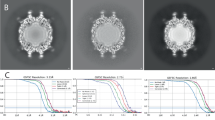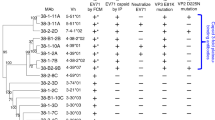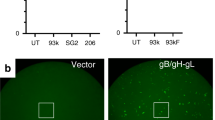Abstract
The crystal structure of the complex between the Fab fragment of C3, a neutralizing antibody for poliovirus, and a peptide corresponding to the viral epitope has been determined at 3.0 Å resolution. Although this antibody was originally raised to heat inactivated (noninfectious) virus particles, it strongly neutralizes the Mahoney strain of type 1 poliovirus. Eleven peptide residues are well-defined in the electron-density map and form two type I β-turns in series. At the carboxyl end, the peptide is bound snugly in the antibody-combining site and adopts a conformation that differs significantly from the structure of the corresponding residues in the virus. Structural comparisons between the peptide in the complex and the viral epitope suggests that on binding to infectious virions, this antibody may induce structural changes important for neutralization.
This is a preview of subscription content, access via your institution
Access options
Subscribe to this journal
Receive 12 print issues and online access
$189.00 per year
only $15.75 per issue
Buy this article
- Purchase on Springer Link
- Instant access to full article PDF
Prices may be subject to local taxes which are calculated during checkout
Similar content being viewed by others
References
Wilson, I.A. & Stanfield, R.L. Antibody-antigen complexes. Curr. Opin. struct. Biol. 3, 113–118 (1993).
Horaud, F. et al. Identification and characterization of a continuous neutralization epitope (C3) present on type 1 poliovirus. Prog. med. Virol. 34, 129–155 (1987).
Blondel, B., Akacem O., Crainic, R., Coullin, P. & Horodniceanu, F. Detection by monoclonal antibodies of an antigenic determinant critical for poliovirus neutralization present on VP1 and on heat-inactivated virions. Virology 126, 707–710 (1983).
Fricks, C.E. & Hogle, J.M. Cell-induced conformational change in poliovirus: externalization of the amino terminus of VP1 is responsible for liposome binding. J. Virol. 64, 1934–1945 (1990).
Wychowski, C. et al. A poliovirus type 1 neutralization epitope is located within amino acid residues 93 to 104 of viral capsid polypeptide VP1. EMBO 2, 2019–2024 (1983).
Minor, P.D. et al. Location and primary structure of a major antigenic site for poliovirus neutralization. Nature 301, 674–679 (1983).
Icenogle, J. et al. Neutralization of poliovirus by a monoclonal antibody: kinetics and stoichiometry. Virology 127, 412–425 (1983).
Diamond, D.C. et al. Antigenic variation and resistance to neutralization in poliovirus type 1. Science 229, 1090–1093 (1985).
Blondel, B. et al. Mutations conferring resistance to neutralization with monoclonal antibodies in type 1 poliovirus can be located outside or inside the antibody-binding site. J. Virol. 57, 81–90 (1986).
Minor, P.D., Ferguson, M., Evans, D.M.A., Almond, J.W. & Icenogle, J.P. Antigenic structure of poliovirus of serotypes 1,2 and 3. J. gen. Virol. 67, 1283–1291 (1986).
Hogle, J.M., Chow, M. & Filman, D.J. Three-dimensional structure of poliovirus at 2.9 Å resolution. Science 229, 1358–1365 (1985).
Mosser, A.G., Leippe, D.M. & Reuckert. R.R. in Molecular Aspects of Picornavirus Infection and Detection; (eds., Semler, B.L. & Ehrenfeld E.) 155–167 (American Society for Microbiology, Washington, D.C.; 1989).
Emini, E.A., Kao, S.-Y., Lewis, A.J., Crainic, R. & Wimmer, E. Functional basis of poliovirus neutralization determined with monospecific neutralizing antibodies. J. Virol. 46, 466–474 (1983).
Kabat, E.A., Wu, T.T., Perry, H.M., Gottesman, K.S. & Foeller, C. Sequences of Proteins of Immunological Interest (National Institutes of Health: Bethesda, MD;1991).
Corbet, S., Milili, M., Fougereau, M. & Schiff, C. Two Vκ germline genes related to the gat idiotypic network (Ab1 and Ab3/Ab1′) account for the major subfamilies of the mouse Vk-1 variability subgroup. J. Immunol. 138, 932–939 (1987).
Pincus, S.H. & Carmack, C.E. Variables regions of antibodies to synthetic polypeptides—III. Antibodies arising in response to administration of anti-idiotype. Molec. Immunol. 29, 811–819 (1992).
Giorgetti, C.A. & Press, J.L. A peptide sequence mimics the epitope on the multideterminant antigen (Tyr,Glu)-Ala-Lys that induces the dominant H10/Vk1+ primary antibody response. J. Immunol. 152, 136–145 (1994).
Caton, A.J. Compartive sequence analysis of C017-1A antigen-specific monoclonal antibodies. Hybridoma 5, S11–S16 (1986).
Arévalo, J.H., Stura, E.A., Taussig, M.J. & Wilson, I.A. Three-dimensional structure of an anti-steroid Fab' and progesterone-Fab' complex. J. molec. Biol. 231, 103–118 (1993).
Rini, J.M. et al. Crystal structure of an HIV-1 neutralizing antibody 50.1 in complex with its V3 loop peptide antigen. Proc. natn. Acad. Sci., U.S.A. 90, 6325–6329 (1993).
Rathburn, G.A., Otani, F., Milner, E.C.B., Capra, J.D. & Tucker, P.W. Molecular characterization of the A/J J558 family of heavy chain variable region gene segments. J. molec. Biol. 202, 383–395 (1988).
Harris, L.J. et al. The three-dimensional structure of an intact monoclonal antibody for canine lymphoma. Nature 360, 369–372 (1992).
Rini, J.M., Schulze-Gehmen, U. & Wilson, I.A. Structural evidence for induced fit as mechanism for antibody-antigen recognition. Science 255, 959–965 (1992).
Connolly, M.L. Analytical molecular surface calculation. J. appl. Crystallogr. 16, 548–558 (1983).
Stanfield, R.L., Takimoto-Kamimura, M., Rini, J.M., Profy, A.T. & Wilson, I.A. Major antigen-induced domain rearrangements in an antibody. Structure 1, 83–93 (1993).
Tormo, J. et al. Three-dimensional structure of the Fab fragment of a neutralizing antibody to human rhinovirus serotype 2. Prot. Sci. 1, 1154–1161 (1992).
Tulip, W.R., Varghese, J.N., Laver, W.G., Webster, R.G. & Colman, P.M. Refined crystal structure of the influenza virus N9 neuraminidase-NC41 Fab complex. J. molec. Biol. 227, 122–148 (1992).
Laskowski, R.A., MacArthur, M.N., Moss, D.S. & Thornton, J.M. PROCHECK: A program to check the stereochemical quality of protein structures. J. appl. Cryst. 26, 283–291 (1993).
Ghiara, J.B., Stura, E.A., Stanfield, R.L., Profy, A.T. & Wilson, I.A. Crystal structure of the principal neutralization site of HIV-1. Science 264, 82–85 (1994).
Stanfield, R.L., Fieser, T.M., Lerner, R.A. & Wilson, I.A. Crystal structures of an antibody bound to a peptide and its complex with peptide antigen at 2.8 Å. Science 248, 712–719 (1990).
Van der Werf, S. et al. Localization of a poliovirus type 1 neutralization epitope in viral capsid polypeptide VP1. Proc. natn. Acad. Sci., U.S.A. 80, 5080–5084 (1983).
Nomoto, A. et al. Complete nucleotide sequence of the attenutated poliovirus Sabin 1 strain genome. Proc. natn. Acad. Sci., U.S.A. 79, 5793–5797 (1982).
Reynolds, C., Birnby, D. & Chow M. Folding and processing of the capsid protein precursor P1 is kinetically retarded in neutralization site 3B mutants of poliovirus. J. Virol. 67, 1734–1738 (1992).
Martin, A. et al. Use of type 1/type 2 chimeric poliovirus to study determinants of poliovirus type 1 neurovirulence in a mouse model. Virology 180, 648–658 (1991).
Sheriff, S. et al. Three-dimentional structure of an antibody-antigen complex. Proc. natn. Acad. Sci., U.S.A. 84, 8075–8079 (1987).
Padlan, E.A. et al. Structure of an antigody-antigen complex: crystal structure of the HyHel-10 Fab-lysozyme complex. Proc. natn. Acad. Sci., U.S.A. 86, 5938–5942 (1989).
Fischmann, T.O. et al. Crystallographic refinement of the three-dimensional structure of the FabD1.3-lysozyme complex at 2.5 Å resolution. J. biol. Chem. 266, 12915–12920 (1991).
Liu, H. et al. Structure determination of an Fab fragment that neutralizes human rhinovirus 14 and analysis of the Fab-virus complex. J. molec. Biol. 240, 127–137 (1994).
Smith, T.S. et al. Structure of human rhinovirus complexed with Fab fragments from a neutralizing antibody. J. Virol. 1148–1158 (1993).
Huse, W.D. et al. Generation of a large combinatorial library of the immunoglobulin repertoire in phage lambda. Science 246, 1275–1281 (1989).
Short, J.M., Fernandez, J.M., Sorge, J.A. & Huse, W.D. λzap: a bacteriophage λ expression vector with in vivo excision properties. Nucleic Acids Res. 16, 7583–7600 (1988).
Chothia, C., Novotny, J., Bruccoleri, R. & Karplus, M. Domain association in immunoglobulin molecules. The packing of variable domains. J. molec. Biol. 186, 651–663 (1985).
Balanant, J., Guillot, S., Candrea, A., Delpeyroux, F. & Crainic, R. The natural genomic variability of poliovirus analyzed by a restriction fragment length polymorphism assay. Virology 184, 645–654 (1991).
Chow, M. & Baltimore, D. Isolated poliovirus capsid protein VP1 induces a neutralization response in rats. Proc. natn. Acad. Sci., U.S.A. 79, 7518–7521 (1982).
Stura, E.A. & Wilson, I.A. Analytical and Seeding Techniques. Meth. Enzymol. 38–49 (1990).
Matthews, B.W. Solvent content of protein crystals. J. molec. Biol. 33, 491–497 (1968).
Howard, A.J. et al. The use of an imaging proportional counter in macromolecular crystallography. J. appl. Crystallogr. 20, 383–387 (1987).
Wilson, I.A., Rini, J.M., Fremont, D.H., Fieser, G.G. & Stura, E.A. X-ray crystallographic analysis of free and antigen-complexed Fab fragments to investigate structural basis of immune recognition. Meths. Enzymol. 203, 153–176 (1991).
Bernstein, F.C. et al. The Protein Data Bank: a computer-based archival file for macromolecular structures. J. molec. Biol. 112, 535–542 (1977).
Saul, F.A. & Poljak, R.J. Crystal structure of human immunoglobulin fragment fab new refined at 2.0 Å resolution. Proteins 14, 363–371 (1992).
Marquart, M., Deisenhofer, J., Huber, R. & Palm, W. Crystallographic refinement and atomic models of the intact immunoglobulin molecule Kol and its antigen-binding fragment at 3.0 Å and 1.9 Å resolution. J. molec. Biol. 141, 369–391 (1980).
Suh, S. et al. The galactan-binding immunoglobulin Fab J539: an X-ray diffraction study at 2.6 Å. Proteins: 1, 74–80 (1986).
Satow, Y., Cohen, G.H., Padlan, E.A. & Davies, D.R. The phosphorylcholine binding immunoglobulin Fab McPc603: an X-ray diffraction study at 2.7 Å. J. molec. Biol. 190, 593–604 (1986).
Gibson, A.L. et al. Differences in crystal properties and ligand affinities of an antifluorescyl Fab (4-4-20) in two solvent systems. Proteins 3, 155–160 (1988).
Fitzgerald, P.M.D. MERLOT, an integrated package of computer programs for the determination of crystal structures by molecular replacement. J. appl. Crystallogr. 21, 273–278 (1988).
Brünger, A.T. X-PLOR Manual, Version 3.1 (Yale University: New Haven, CT; 1992).
Harada, Y., Lifchitz, A. & Berthous, J. A translation function combining packing and diffraction information: an application to lysozyme (high-temperature form). Acta crystallogr. A 37, 398–406 (1981).
Jones, A.T. Interactive computer graphics: FRODO. Methods Enzymol. 115, 157–171 (1985).
Bhat, T.N. & Cohen, G.H. OMITMAP: an electron density map suitable for the examination of errors in macromolecular models. J. appl. Crystallogr. 17, 244–248 (1984).
Nicholls, A., Sharp, K.A. & Honig, B. Protein folding and association: insights form the interfacial and thermodynamic properties of hydrocabons. Proteins 11, 281–296 (1991).
Evans, S.V. SETOR: hardware lighted three-dimensional solid model representaions of macromolecules. J. molec. Graphics 11, 134–138 (1990).
Author information
Authors and Affiliations
Rights and permissions
About this article
Cite this article
Wien, M., Filman, D., Stura, E. et al. Structure of the complex between the Fab fragment of a neutralizing antibody for type 1 poliovirus and its viral epitope. Nat Struct Mol Biol 2, 232–243 (1995). https://doi.org/10.1038/nsb0395-232
Received:
Accepted:
Issue Date:
DOI: https://doi.org/10.1038/nsb0395-232
This article is cited by
-
Neutralizing antibody to human rhinovirus 14 penetrates the receptor-binding canyon
Nature (1996)
-
Molecular geography
Nature Structural & Molecular Biology (1995)



